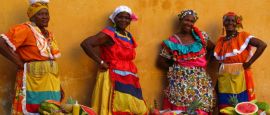Colombia Weather, climate and geography
Weather & climate
Colombia’s weather offers all four seasons and they remain generally unchanged throughout the year due to Colombia’s proximity to the equator. The topographical diversity of Colombia means that you will find snowy mountain peaks, warm Caribbean beaches and a rainy tropical rainforest at any time of year. This makes the Colombian climate extremely unique and attracts an increasing number of visitors annually.
Bogota, the largest city and capital, is situated in the Eastern Andes region and the weather is generally spring-like. Although sunny days can still get quite hot, there are many cool days and nights. The average high temperature throughout the year hovers around 20°C (68°F). For more information about weather in Bogota and things to do there, check out our Bogotá guide.
Located in Northern Colombia on the Caribbean coast, Cartagena is another popular spot for tourists. It is a port city known for rich history and beautiful beaches. With temperatures rarely dropping below 30°C (86°F), Cartagena’s climate is perfect for those looking for a warmer, relaxing vacation. You can learn more about Cartagena here.
The Amazon region is a place where tourists go to explore the jungle and marvel at the unique species of plants and animals. Located in southern Colombia, the Amazon basin generally stays warm all year round and finds little relief from rain.
Although the seasons are unchanging, the best time of year to visit Colombia is December to March. These are the drier months and allow tourists to enjoy more outdoor activities. Major religious holidays will also impact the best time of year to visit. Santa Semana, Holy Week in April, is a stunning time to travel to Colombia. There are ostentatious celebrations and candle-lit mass services to celebrate the Catholic faith. But, hotels book up fast for this week and double their rates, so it is smart to plan in advance.
Generally, Colombia’s weather requires light clothing suitable for warm to hot weather. However, if you are staying in a city in the Andes such as Bogotá, long shirts and pants are recommended – preferably a jacket as well.
If you are planning to hike in the colder mountainous regions you’ll need durable boots. Breathable walking sandals with good support are recommended for more rural areas. If you are visiting the Amazon, light clothing is required, but long sleeves and trousers for the evenings are useful to prevent mosquito bites. No matter where you are staying, a waterproof jacket is smart to bring for any time of year.
Geography
Colombia is situated in South America, bordered by the Caribbean Sea, the Pacific Ocean and Panama on the North, Ecuador and Peru on the South, and Venezuela and Brazil on the east. Colombia is home to the Andes, the world’s longest above-water mountain range. The Western and Central Cordilleras of the Andes Mountains are in the west of Colombia – stretching from Ecuador to the Caribbean Sea. The Eastern Cordillera, the longest range, rises northeast from Ecuador to Venezuela.
Colombia is divided into three different climatic zones based on elevation. The Tierra Caliente, meaning hot land, is the region below 900 meters (2,953 ft) in elevation. This region spreads over about 86% of the total area of Colombia. The Tierra Templada, meaning temperate land, ranges between 900 to 1,980 meters (6,496 ft) in elevation and is home to most of the country’s population. The area located between 1,980 and 3,500 meters (11,483 ft) is called The Tierra Fria, meaning cold land. The mean range of temperature there is between 10 and 19°C (50 and 66.2°F).
The combined area of the flat grassy prairies in eastern Colombia and the jungles and towering rainforests of the Amazon in the south covers nearly 55% of Colombia, yet only 3% of Colombians live there.
The tallest peak in Colombia is actually not in the Andes but found in a separate mountain range. It is Pico Cristobal Colon in the Sierra Nevada de Santa Marta range and has an estimated height of 5,775 metres (18,950 ft).
Do you have any Feedback about this page?
© 2025 Columbus Travel Media Ltd. All rights reserved. No part of this site may be reproduced without our written permission, click here for information on Columbus Content Solutions.




 You know where
You know where